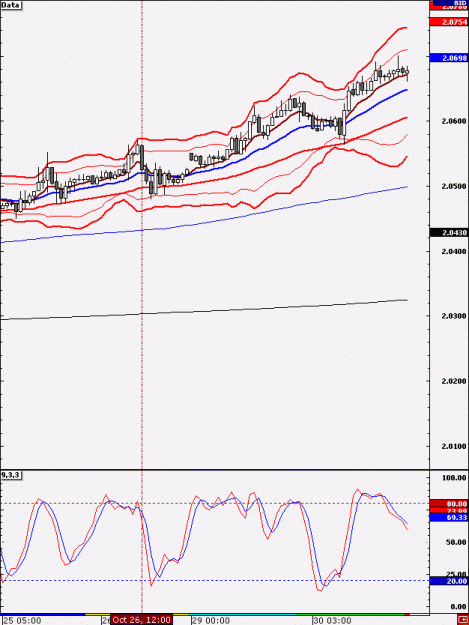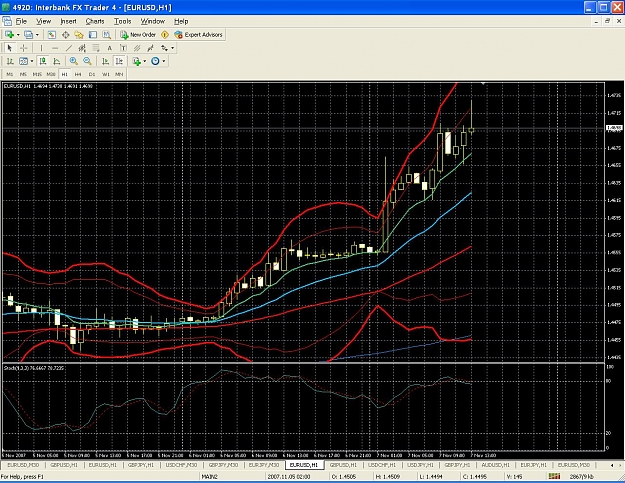I would like to share with you a method of trading that I have been using with success for over a year.
Itís not a mechanical Ďset and forgetí system - there is an element of discretion involved, both with the decision to enter a trade, and setting stop losses and profit targets. And itís no ĎHoly Grailí, as with life in general, you will only get out of it what you put in.
When I started out trading, I experimented with pretty much every indicator out there, looking for the perfect mechanical system. And I am pretty much convinced that there isnít one. In my experience, the vast majority of purely mechanical systems are too reliant on a particular set of variables/market conditions, and when there is a deviation from those conditions, the vast majority of them fail.
It is far better to arm yourself with a few simple tools, and learn how to use those tools under any market conditions. Using this approach I have developed a method which gives high probability set ups, is consistently profitable and is not dependent on any particular market environment. I trade this method successfully in both ranging and trending markets.
My method trades off a 1H chart in conjunction with a 4H chart and uses the following tools:
Itís not a mechanical Ďset and forgetí system - there is an element of discretion involved, both with the decision to enter a trade, and setting stop losses and profit targets. And itís no ĎHoly Grailí, as with life in general, you will only get out of it what you put in.
When I started out trading, I experimented with pretty much every indicator out there, looking for the perfect mechanical system. And I am pretty much convinced that there isnít one. In my experience, the vast majority of purely mechanical systems are too reliant on a particular set of variables/market conditions, and when there is a deviation from those conditions, the vast majority of them fail.
It is far better to arm yourself with a few simple tools, and learn how to use those tools under any market conditions. Using this approach I have developed a method which gives high probability set ups, is consistently profitable and is not dependent on any particular market environment. I trade this method successfully in both ranging and trending markets.
My method trades off a 1H chart in conjunction with a 4H chart and uses the following tools:
- Bollinger Bands. I use 2 sets of Bollinger Bands, set at 2 standard deviations and 3 standard deviations over 20 periods. As we will see, these bands provide the backbone of my method, and are my starting point in my trade analysis.
- Stochastics. There are so many oscillating indicators out there, and Iíve tested most of them over the years, but I always come back to the good old fashioned stochs. The settings I use are 9,3,3.
- Moving averages. These give me a feel for direction and trend, whether there is a strong trend in place, if trend is changing, or whether the market is ranging. Equally importantly, they also provide dynamic levels of support and resistance, and are very useful to determine profit targets and stop loss levels. I use 8 EMA and 21 EMA to track short term direction and a 55EMA to track medium term trend. All good old fashioned fib numbers. These are all exponential MAís Ė I think itís more important to get a feel of more recent price action (and more importantly they tested better during my backtesting). I also have on my charts a 200 and 800 SMA for longer term trend.
- Confluence. Hey, where do I find the ĎConfluence indicatorí on my charting platform? Ha ha, remember what I said about this not being a Ďset and forgetí system? Confluence is where different MAs, support and resistance, Bollinger Bands, fib lines, or other technical indicators occur at identical price levels. Confluence is a powerful tool, as identifying these levels enables us to enter (or exit) trades with a much greater degree of confidence. Identifying these areas of confluence is key to high probability trading, and is a key element in my trading strategy.
At present I am only trading this method on GBP/USD, EUR/USD and USD/JPY, and taking my trades off a 1H chart (in conjunction with a 4H chart). There is no reason in theory why this strategy will not work with any other currency pair ( or indeed other time frames). Itís just that these are the pairs I have tested this method with, and the pairs whose price movement I am very familiar with.
In my next post, Iíll illustrate how I take my trades.






